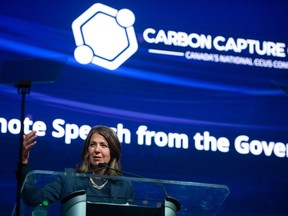Alberta has set an ambitious target to be a carbon-neutral — net zero — economy by 2050. Attending COP28, I had the opportunity to share some of the net-zero energy research happening at the University of Alberta (UA) and deepen our global collaborations. As a global leader in developing net-zero energy solutions, UA has a key role to play in ensuring a sustainable and prosperous future for Alberta’s energy sector.
Advertisement 2
THIS CONTENT IS RESERVED FOR SUBSCRIBERS ONLY
Subscribe now to read the latest news in your city and across Canada.
- Exclusive articles by David Staples, Keith Gerein and others, Oilers news from Cult of Hockey, Ask EJ Anything features, the Noon News Roundup and Under the Dome newsletters.
- Unlimited online access to Edmonton Journal and 15 news sites with one account.
- Edmonton Journal ePaper, an electronic replica of the print edition to view on any device, share and comment on.
- Daily puzzles, including the New York Times Crossword.
- Support local journalism.
SUBSCRIBE TO UNLOCK MORE ARTICLES
Subscribe now to read the latest news in your city and across Canada.
- Exclusive articles by David Staples, Keith Gerein and others, Oilers news from Cult of Hockey, Ask EJ Anything features, the Noon News Roundup and Under the Dome newsletters.
- Unlimited online access to Edmonton Journal and 15 news sites with one account.
- Edmonton Journal ePaper, an electronic replica of the print edition to view on any device, share and comment on.
- Daily puzzles, including the New York Times Crossword.
- Support local journalism.
REGISTER TO UNLOCK MORE ARTICLES
Create an account or sign in to continue with your reading experience.
- Access articles from across Canada with one account.
- Share your thoughts and join the conversation in the comments.
- Enjoy additional articles per month.
- Get email updates from your favourite authors.
Article content
Today, Alberta emits far more greenhouse gas emissions than any other province in Canada (almost double that of Ontario), primarily driven by industrial emissions, including oil and gas production. Getting to net zero by 2050 is going to require a concerted effort. In close collaboration with industry and government and building on decades of leadership in energy research, UA has launched a major new research project — Canadian Net Zero Energy Solutions (CANZES) — to develop the technologies Alberta will need to achieve net zero by 2050. We are bringing together some of the top researchers in the world, working to address one of the greatest challenges facing the globe.
Article content
Achieving net zero will require developing new technologies and refining existing ones to bring them to full-scale implementation. It will require major investments in research and billions of dollars of new infrastructure. There is no magic bullet that will get us to net zero. Instead, we need a multifaceted and multi-disciplinary approach.
We are focusing on five critical areas of research priority that will be essential for Alberta to achieve net zero by 2050: carbon capture, utilization and storage (CCUS), hydrogen, critical minerals, resilient and smart electrical grids, and land and water reclamation. In all five areas, we will leverage our expertise in artificial intelligence and quantum science.
By signing up you consent to receive the above newsletter from Postmedia Network Inc.
Article content
Advertisement 3
Article content
With two multibillion-dollar projects already underway (Air Products and Dow Chemical), Alberta is home to some of the largest CCUS projects in the world. However, more research will be needed to demonstrate economic feasibility at scale and technological maturity for many CCUS strategies.
UA research is advancing point-source and direct air capture, including geological storage. It includes CO2 utilization (using CO2 as raw materials for other products), which will be essential for developing next-generation technologies that reduce the cost of CCUS. We are also examining ways to build public acceptance and trust, which are critical to the success of CCUS projects in Alberta and across Canada.
CCUS research will also help Alberta capitalize on producing and using clean hydrogen. When burned for energy, hydrogen emits only water, which means it can be a major source of clean energy. UA research is advancing the whole spectrum of hydrogen research, including production, transportation, storage and utilization.
Combining CCUS with Alberta’s vast natural gas resources, along with Alberta’s rapidly growing renewables (wind and solar), Alberta can be a leading global producer of clean hydrogen. With a worldwide hydrogen market estimated to be worth over $2.5 trillion by 2050, the potential for Alberta is enormous.
Advertisement 4
Article content
As more transportation moves to electric vehicles, the world urgently needs more critical minerals, including lithium, necessary for battery production. UA research is exploring how to extract lithium from oilfield brines in Alberta, an alternative to traditional sources of lithium, which is found in hard rocks around the world, is costly to mine and environmentally intrusive.
Electric vehicles also mean huge new demands on the electrical grid. Renewable energy systems like solar and wind also create challenges in ensuring these energy systems are compatible with today’s electrical grid. UA research is leading the way in developing resilient and smart electrical grids for clean energy and zero-emissions vehicles.
Land and water reclamation are key challenges in developing sustainable energy systems. UA research is at the forefront of effective, integrated and low-energy treatment strategies for municipal and industrial wastewater.
In 1944, UA researcher Dr. Karl Clark developed the technology to separate bitumen from sand, leading to the first commercial development of the oil sands in 1967. Over the years, UA research has continued to support Alberta’s thriving energy sector. That support has never been more important today as Alberta moves to net zero by 2050.
Simply imposing caps on carbon will not create a sustainable emissions reduction plan. Instead, we can only realistically meet our emissions targets by developing the technologies that can make net zero a reality while sustaining access to affordable and reliable energy. CANZES will be an important part of the path forward to the great benefit of all Albertans and beyond.
Bill Flanagan is president and vice-chancellor of the University of Alberta.
Article content



